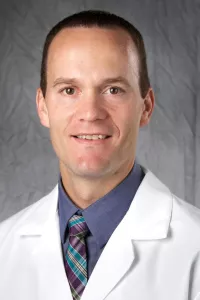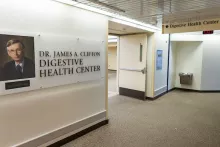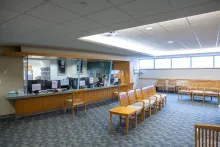Heartburn, Reflux, and GERD
- For all other requests:
- 1-800-777-8442
Gastroesophageal Reflux Disease (GERD)
Gastroesophageal reflux disease (GERD) is a condition in which the contents of the stomach escape backwards from the stomach into the esophagus (the tube from the mouth to the stomach).
The most common cause of GERD is when the valve between the stomach and the esophagus, called the lower esophageal sphincter, becomes weak. This allows contents of the stomach to enter (reflux) into the esophagus. The acidic contents of the stomach can cause damage and discomfort which we sense as heartburn. GERD is a very common complaint with as much as 44 percent of Americans experiencing monthly symptoms.
Symptoms
GERD can be broken down into classic and atypical symptoms. Symptoms may get worse when you bend over, lie down, or when you eat. Symptoms may also be worse at night. The most common classic symptoms are heartburn and regurgitation of fluid from the stomach into the esophagus.
Less Common, or Atypical Symptoms, Can Include the Following:
- Asthma or shortness of breath
- Bad taste in the back of one's mouth
- Chest pain
- Cough
- Dental erosion
- Difficulty swallowing
- Hoarseness or a change in voice
- Nausea after eating
- Sore throat
Possible Complications
- Barrett’s esophagus—a change in the type of cell lining in the esophagus that increases the risk of esophageal cancer
- Chronic cough or hoarseness
- Dental problems
- Esophagitis, or inflammation of the lining of the esophagus
- Stricture (a narrowing of the esophagus due to scarring)
- Worsening of asthma or bronchospasm (irritation and spasm of the airways)
Causes of and Risk Factors for GERD
Risk Factors for Reflux and GERD Include:
- Dietary choices—acidic or fatty meals, caffeine, eating close to bedtime, and large meals
- Hiatal hernia (a condition in which part of the stomach moves above the diaphragm, which is the muscle that separates the chest and abdominal cavities)
- Obesity
- Pregnancy
- Scleroderma
- Smoking or alcohol use
Symptoms Can Also Be Caused by Certain Medicines, Such As:
- Anticholinergics (e.g., for seasickness)
- Beta-blockers for high blood pressure or heart disease
- Bronchodilators for asthma
- Calcium channel blockers for high blood pressure
- Dopamine-active drugs for Parkinson's disease
- Progestin for abnormal menstrual bleeding or birth control
- Sedatives for insomnia or anxiety
- Tricyclic antidepressants
Diagnosing GERD
You may not need any tests if your symptoms are mild. If your symptoms are severe or they come back after you have been treated, your doctor may perform a test called an upper endoscopy (EGD):
- To examine the lining of the esophagus, stomach, and first part of the small intestine.
- Done under gentle sedation with a small camera (flexible endoscope) that is inserted down the throat.
You May Also Need One or More of the Following Tests:
- An esophageal manometry which measures the strength and coordination of the muscular contractions of the esophagus
- A pH test that measures how often stomach acid refluxes back up into the esophagus from the stomach
- An upper gastrointestinal series (UGI) is often ordered to identify unexpected esophageal pathology such as a stricture, hiatal hernia, or ineffective contractions.
Treating GERD
Lifestyle Changes
- Avoidance of large meals comprised of acidic and fatty foods as well as alcohol, caffeinated beverages, and carbonated beverages
- Avoid late-night meals
- Raise the head of the bed
- Weight management to achieve a healthy weight with a BMI <30kg/m2
- When your doctor gives you a new medicine, ask whether it will make your heartburn worse
Medications
You may use over-the-counter antacids after meals and at bedtime. Common side effects of antacids include diarrhea or constipation. Other over-the-counter and prescription drugs can treat GERD. They work more slowly than antacids but give you longer relief. Your pharmacist, doctor, or nurse can tell you how to take these drugs.
- H2 blockers lower the amount of acid released in the stomach
- Proton pump inhibitors (PPIs) also decrease the amount of acid produced in your stomach, but to a greater degree than that which is achieved with H2 blockers
It is important to note that medications only address the acid level of the fluid that is refluxing from the stomach into the esophagus. In other words, the fluid may be less acidic, but it will still continue to move backwards from the stomach into esophagus. For some, this change in pH is adequate for symptom resolution. For others, their symptoms will persist despite maximum medical treatment.
Surgery
Anti-reflux surgery may be an option for patients whose symptoms do not go away with lifestyle changes and medication.
At the University of Iowa, we use two types of surgery to address GERD.
- Nissen fundoplication:
- Also known as laparoscopic fundoplication
- A surgical procedure to treat GERD and hiatal hernias
- Introduced in 1955, the procedure consists of wrapping the upper part of the stomach around the lower part of the esophagus and reinforcing the lower esophageal sphincter to stop inappropriate GERD.
- LINX:
- A relatively new surgical option
- A flexible ring of small magnets is placed around the lower esophageal sphincter during a minimally invasive procedure
- Similar to the Nissen fundoplication, Linx stops pathologic reflux through the reinforcement of the lower esophageal sphincter.
- It differs from the Nissen in that it has a mildly improved side effect profile.
For an explanation of the LINX procedure, watch this whiteboard video.
Our Care Team



- Gastroenterology
Not sure which Heartburn, Reflux, and GERD provider is right for you?
Locations and Offices


Patient Stories
